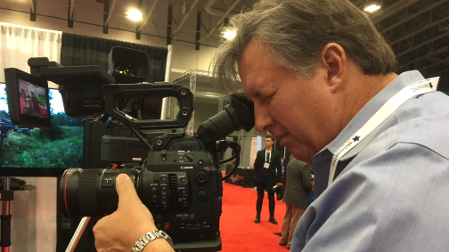2017 GV Expo: A Look at Present and Future of Industry
WASHINGTON—The 2017 Government Video Expo & National Drone Show was held Nov. 28-30, with the first day (Nov. 28) set aside exclusively for the DC Post Production Conference. The exhibition opened on Wednesday, Nov. 29, and the content seen across the conference program and show floor reflected broad technical and regulatory trends in video production and distribution.

Bill McKnight gets up close with the C300 Mark II camera from Canon.
While many attendees on the exhibition floor and in the seats at the conference were clearly from local, state or federal government entities, a significant number were from the thriving regional production community or one of the scores of educational institutions or non-profits that dot the metropolitan Washington, D.C. region.
The diversity of attendees was reflected in the conference program and the kit seen on the show floor: Everything from basic production tools such as lighting and lenses and mics on through to more esoteric things from the evolving world of UAVs or VR/AR had a presence.
VR/AR is arguably the newest trend. The University of Maryland Virtual Reality Club—itself only three years old but notably sponsored by VR specialist Oculus VR and Lockheed Martin—had a corner booth that saw attendees lining up for demos and information. The range of interest here was from the merely curious to government and military representatives who had real security and training applications in mind.
The sector is new in the gaming world, and very new for other applications. It seems to be evolving concurrently in the “consumer” and “pro” market.
The merger of the professional and consumer worlds is nothing new in the broader AV and broadcast sectors, and a presentation from Steve Koenig, senior director of market research for the Consumer Technology Association, described a future where VR/AR and AI would bring immersive experiences for practical applications beyond the entertainment sector. Koenig described a future where VR could replace face-to-face meetings and help veterans overcome post-traumatic stress disorder, for example. He stressed that the technology can and will deliver a sense of presence never seen before.
The professional video industry's #1 source for news, trends and product and tech information. Sign up below.
Needless to say, the engineers and production teams designing the VR/AR future are on the cutting edge, and anyone wishing to create virtual experiences needs access to information and training beyond the norm. It’s an arena that people need to learn about if things like ‘virtual trade shows,’ or disaster simulations are to become common.
EDUCATION AND BEYOND
Education was also a central part of Black magic Designs’ GV Expo presence. It sponsored the Production Solutions Pavilion right at the front of the exposition hall, where crowds could learn about collaboration and security in a workflow, simplifying live streaming, and the latest in camera designs and applications.
Jason Druss, product specialist with Blackmagic, said the company’s range of production equipment from cameras to switchers to recording devices, fit the broad range of customers the show attracts.
“We’re happy to be able to educate and exchange ideas with government video professionals about workflows and our products, and we’ve seen a wide range of attendees from all sorts of areas,” said Druss. “We’re here for everybody.”
Blackmagic had a good display of kit available on the floor, including its ATEM Television Studio Pro HD live production switcher, the URSA Mini Pro camera that combines the image quality of the URSA Mini 4.6K with the features and controls of a traditional broadcast camera, and the HyperDeck Studio Mini, a tiny Ultra HD broadcast deck with 10-bit recording and playback, dual SD/UHS-II card recorders and FTP media upload.
Notable for many of those in attendance, the company’s Web Presenter makes any SDI or HDMI video source appear as a USB webcam for higher quality web streaming using software such as Skype or streaming platforms such as YouTube Live, Facebook Live and others.
BACK FOR MORE
One company making its second GV Expo appearance after a 2016 debut was Enco. While the company’s visual radio and automated playout offerings attracted attention, the hot product this year was clearly its enCaption4 hardware/software solution that can automatically generate captioning on live or recorded video.
Ken Frommert, president of ENCO, said that the product was a way that content creators could provide real-time, live captioning without any advance notice and without the cost of live captioners or signers. Frommert said that both ADA and FCC rules were driving the need for this product.
“(enCaption) has been really hot at this show because everyone needs captioning now,” said Frommert. He added that GV Expo 2016 was critical for establishing a presence with government agencies who became customers. This year, the show was all about visiting with the customers established last year and securing new contacts: “In our second year of the show, word of mouth (from established government customers) seems to have helped a lot.”
Securing government business means a lot. A scan of attendee badges revealed an expected strong presence from various federal agencies, defence, state and local governments, police and fire departments.
PRODUCTION HOUSES AND MORE
Jeffrey Kramer of production company Kramer Communications in nearby Prince George’s County, Md., was at GV Expo looking for “new toys in general,” with a more specific need to get a new NLE to replace the company’s FCP software. A firefighter, Kramer has mixed his vocation with his avocation on many occasions—the production company’s “safer” brand of recruitment, retention and training videos is aimed at local fire departments and similar entities.
Basic production needs such as NLEs were on the minds of many local production companies wandering the floor. Bill McKnight of McKnight Creative Media LLC was at the Canon booth looking at cameras and lenses, including the EOS C300 Mark II Digital Cinema Camera, a second-gen Cinema EOS 4K camera system with a wide range of new and improved features including 4K/2K/Full HD internal and external recording (including 4K RAW output) and a new 10-bit Canon Log 2 Gamma.
The Canon booth had equipment pertinent to a range of customers. Also on stand was the C-700 ENG camera, an ME-20 box camera and units mounted to Telemetrics robotics for studio or surveillance use.

The Intel Falcon 8+ Drone is a pro UAV ideal for inspection and close mapping.
The Ross stand also had a range of its equipment on stand suitable for any live production facility. Products included a Graphite switcher with xpression clip play, the Lightning Control System, the Carbonite Black mid-sized switcher and more. “We’ve had a real mix of local production types and federal government representatives on stand,” said a Ross representative.
Beth Nardin of K 5600 Lighting concurred, saying that GV Expo was the show to show its range of mainly daylight balanced lights to government and military customers, along with a few local production companies. New from the company and on show was the Kurve, a focusing parabolic umbrella, and also a sneak peek of the company’s new-in-2018 Joker II HMI.
On the audio side, Sennheiser showed its SL Ceiling Microphone, which features 29 Sennheiser KE 10-237 pre-polarized condenser microphone capsules designed to blend into any conference room infrastructure. It features beamforming technology that automatically focuses on whoever is speaking in the room. On the opposite end of the usage spectrum was the Ambeo VR mic.
A company with a large presence at a dealer’s booth was NewTek, who reported significant interest in both its IP Series live production system and the NDI technology it is based on. NDI is a bi-directional standard that allows users to share video and audio over IP. It also allows them to send and receive multiple input and output signals between devices on a network.
All technologies tend to evolve as seen in the example of the IP production world—the drive is typically toward “smaller, faster, lighter, cheaper, better.” Another trend is for big players to get involved in a technology as it gains acceptance. One example of this is Intel getting in to the drone/UAV business with its Falcon 8+ Drone, which Stampede had flying in the demo cage on a regular basis throughout the show.
When a technology such as UAVs takes off, smaller side businesses also follow. One seen on the floor was a kickstarter project from 2015 called VUFINE, now in its second generation. This is a small monitor that mounts on glasses, making it ideal for drone monitoring—a user can keep an eye on the drone and the video the drone is capturing simultaneously, staying in compliance with direct line of sight requirements.

